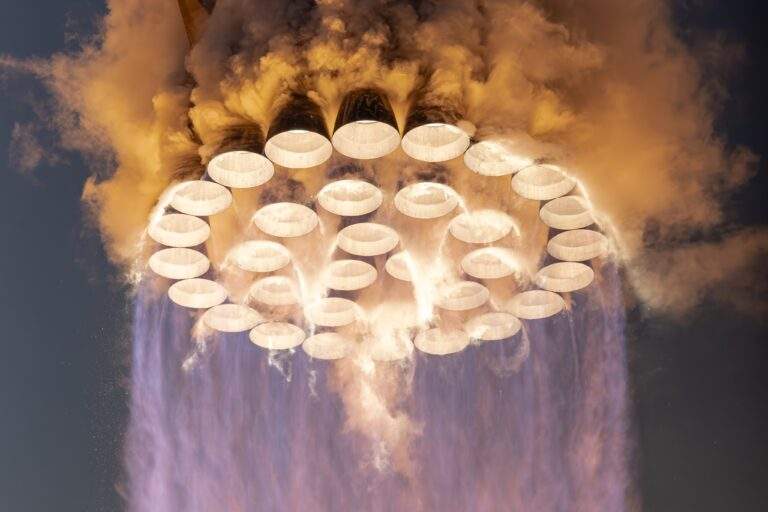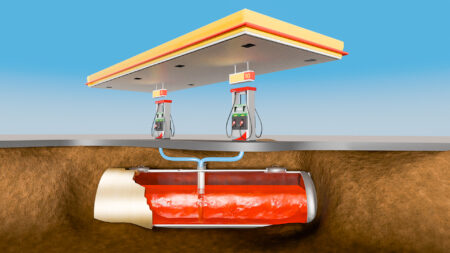At the end of 2018, SpaceX started to increase their activity in the quiet town of Boca Chica. It became clear that this was where they were going to start building and testing their massive Starship rockets. Starship was originally going to be built in California out of carbon fiber – but a sudden change to Starship’s design saw SpaceX move away from Califronia to Texas. Boca Chica gave SpaceX a lot of space, far away from civilization to test their new rockets. Over the last couple of years, SpaceX have hired hundreds of new workers to create a constant 24 hour production line.
SpaceX dog house appears
But one of SpaceX’s newest recruits caught everyone by surprise. Around the launch site, people started to notice a large doghouse with the name Zeus written above it.

After performing a pressure test on one of their Starship prototypes, the launch area was covered in a cloud of liquid nitrogen and a yellow figure appeared from the mist. This little guy is ‘Spot’, the robotic dog made by Boston Dynamics. Boston Dynamics is famous for making some of the most advanced robots in the world – and SpaceX saw an interesting use case for one of them.

Starship testing
Over the last couple of years SpaceX have been rapidly testing their Starship prototypes. This involves filling up the massive fuel tanks with high pressure gas or liquid nitrogen in order to test that the tanks can safely hold their target pressure needed for flight. This was super important in the early days of testing as SpaceX was still figuring out how to weld each of Starship’s ring segments together.
During these tests, it’s common for SpaceX to push the pressure of the vehicle until it breaks. If the vehicle is fully fueled with methane and liquid oxygen, the results can be catastrophic. Because of this, the entire launch site needs to be cleared and the public road that runs through Boca Chica needs to be closed.
Once the test begins, no one is allowed within at least a mile of the launch site, including SpaceX personnel. This isn’t ideal for SpaceX since it can take several hours to confirm that the launch pad is safe and that none of the fueling systems are leaking gas. During this period of time, SpaceX misses out on a lot of data which could help them understand how the vehicle failed.
“Spot” the Boston Dynamics dog
In order to maximize the data captured from these tests, SpaceX bought the Boston Dynamics dog ‘Spot’. This robotic dog is incredibly agile with the ability to climb stairs and deal with the roughest of terrains.
Loaded with cameras, sensors and powerful electric motors, it can use it’s vision to get around obstacles that an ordinary wheeled robot would struggle with. Spot can be controlled remotely via wifi or it can follow specific routes that have been programmed into its memory, this allows SpaceX to analyze the dangerous launch site without putting any humans at risk.
The first proper test of Spot was during the SN7 test where SpaceX pushed a Starship prototype to failure. This test created an enormous cloud of liquid nitrogen which remained at the launch site for a while, causing poor visibility. Amidst the cloud of liquid nitrogen, Zeus was seen inspecting the remains of the prototype and the surrounding area.

Zeus was most likely fitted with cameras and various sensors in order to detect gas leaks from the nearby fueling lines. The cameras give SpaceX an idea of how the vehicle failed and what needs to be done in order to clear the launch pad and fix any damage to the fueling systems. This allows SpaceX to constantly improve the design of their Starship rocket between each prototype.
Having Zeus at the scene of the accident allows SpaceX to capture as much information as possible without ever putting humans at risk. If SpaceX can use robotic dogs like this here on Earth, they might also be useful when we finally send humans to Mars.
Using robots on Mars
The first SpaceX trip to Mars will almost certainly be done without humans. The plan is to send multiple Starships to the Martian surface with enough supplies and technology to set up a base and start mining water and methane. SpaceX could take a group of similar robotic creatures to handle a lot of the setup work.
Although most of the heavy lifting could be done by Starship itself with its onboard crane, many of the setup jobs will need a more precise and delicate touch. The most common design for Martian robots has always been a vehicle with wheels, but a 4 legged robot like Spot could provide an advantage in getting over obstacles like large rocks on the Martian surface.
Since it’s designed for Earth, Spot only has a temperature range from 45 degrees down to -20. But perhaps in the future, SpaceX could collaborate with Boston Dynamics to create a special version of Spot, designed for the Martian surface.
One huge problem that comes with controlling robots on Mars is the time delay. Since it takes around 14 minutes to send data to Mars, controlling robots like the Curiosity rover is an incredibly slow process. Curiosity can only travel around 100 meters per day and each movement has to be carefully planned.
The most useful scenario for Spot on Mars would be to aid humans while they are on the surface. Spot could be controlled in real time from a Martian habitat, allowing equipment to be set up without subjecting humans to the harsh Martian atmosphere.
Once we finally send humans to Mars, they will be able to record and process information at a much higher rate than the rovers that currently occupy the planet. But as SpaceX has shown, humans have their limits. And it seems that our journey into the future of spaceflight won’t be done alone – but hand in hand with our robotic friends.














I don’t think the title of your article matches the content lol. Just kidding, mainly because I had some doubts after reading the article.
Can you be more specific about the content of your article? After reading it, I still have some doubts. Hope you can help me.